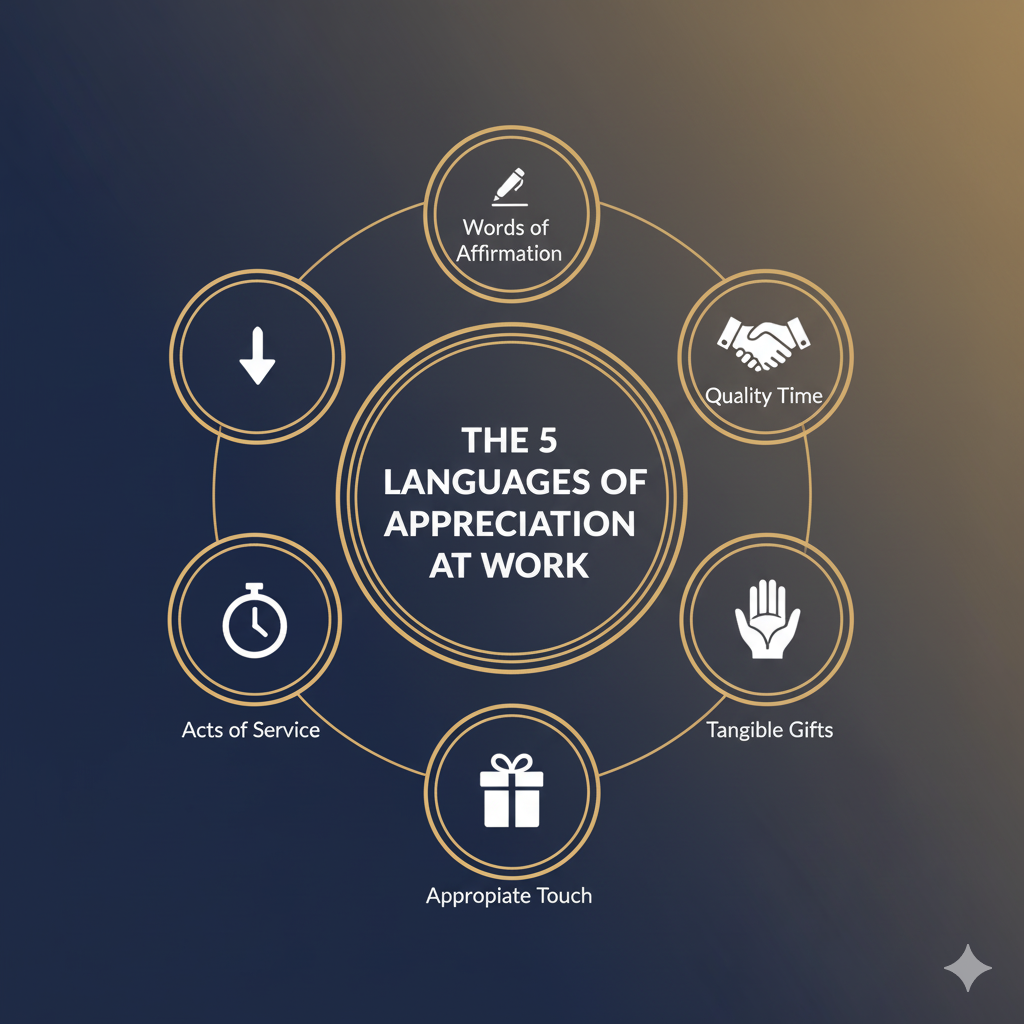Speaking the Right Language of Appreciation in Business
Have you ever praised a team member in front of everyone else for their hard work, only to see them cringe in embarrassment? Or maybe you gave an employee a bonus when they would have been happier with a simple, heartfelt “thank you” note. It’s probably not because you’re not being sincere if your attempts to show thanks sometimes don’t work. Instead, you might be speaking the wrong language.
People have different ways of showing and receiving appreciation, just like they have different languages they speak. Dr. Gary Chapman and Dr. Paul White made the idea popular in their book “The 5 Languages of Appreciation in the Workplace.” It says that what makes one person feel valued might not work for another. Any leader needs to know this. When you say thank you in a way that really connects with your team, you don’t just make them feel good. You also build trust, boost morale, and get people more involved.
Not using the right words of thanks in business can have big effects. Your good intentions may not be enough, and your employees may feel ignored and undervalued. This can cause people to lose interest, work less hard, and eventually leave the company more often. This guide will talk about the five ways people show appreciation at work and give you practical tips on how to find and speak the language your team needs to hear. You can make sure that your thanks are not only heard but also felt by learning how to change your approach.
Five Ways to Show Appreciation at Work
The framework for the languages of appreciation is a great tool for leaders. It lists five different ways that people like to be thanked. The first step to making the workplace more supportive and motivating is to understand each one.
1. Words of Affirmation
Words of Affirmation are most important to people who value them when they are spoken or written. These workers feel most valued when they get specific, positive feedback on the work they do. It’s not enough to just give them compliments; you need to point out their specific skills, hard work, and the good things they do.
How it looks in real life:
- Praise that is specific: Instead of saying, “Good job on the project,” say, “Your analysis of the Q3 report’s data was very helpful in finding a key market opportunity.” Thanks for doing such a great job.
- Recognition in public: If an employee is okay with getting attention from others, praising their work in a team meeting or in a company-wide email can be very motivating.
- Notes in writing: A handwritten thank-you note or a thoughtful email that goes into detail about what they did can be a strong and lasting way to show your appreciation.
For these individuals, words are a direct line to feeling valued. They want to know that their work is important and that their leaders and coworkers are noticing what they do.
2. Time Well Spent
Employees whose primary language is Quality Time feel valued when they receive focused, undivided attention. It’s not about having long, pointless meetings. It’s about real, one-on-one communication where they feel heard and understood. Your time is the most valuable thing they can give you.
How it looks in real life:
- Dedicated Check-ins: Set up regular one-on-one meetings with no distractions (put your phone away!) to talk about their progress, career goals, and any problems they are having.
- Mentorship: Offering to be their mentor and giving them advice and support as they grow in their careers.
- Things to do as a team: Organizing a team lunch or a collaborative brainstorming session where everyone’s input is actively sought and valued.
When you give these workers your time, they know you care about them and want them to do well.
3. Acts of Service
For some, actions speak louder than words. People who like Acts of Service feel most valued when their coworkers or bosses offer them real help and support. This means taking something off their plate, especially when they are feeling stressed. It’s about showing that you’re a team player who is willing to get your hands dirty and help out.
How it looks in real life:
- Giving Help: If you see a team member having trouble meeting a deadline, say, “What can I do to help you get this done?”
- Support that is proactive: Anticipating their needs, like making a complicated process easier or giving them the tools they need before they even ask. Sharing the Workload: When a manager helps with a difficult task, it shows that they are part of the team and not just giving orders from above.
Doing something nice for someone else shows that you care about them and makes them feel like they can trust you.
4. Gifts that can be touched
While some may see gifts as impersonal, for those whose language is Tangible Gifts, a thoughtful present is a powerful symbol of appreciation. The price of the gift doesn’t matter as much as the thought and meaning behind it. It’s a physical sign that their hard work has been seen and appreciated.
How it looks in real life:
- Personalized Gifts: Giving someone a gift that relates to their hobbies or interests, like a gift card to their favorite coffee shop, a book by an author they like, or tickets to see their favorite team play.
- Company Stuff: Company-branded items that are useful and of high quality can also work, but personalizing the gift makes it more special.
- Rewards and Bonuses: Money gifts are a type of real gift, but they work best when they are linked to a specific goal.
A thoughtful gift shows that you care about them as a person, not just as an employee.
5. Touching
Physical Touch is the least common and most subtle way to show appreciation in a work setting. It must always be approached with extreme caution and respect for personal and professional boundaries. Gestures that are appropriate are only those that are based on the situation, like a congratulatory handshake, a high-five for a team win, or a pat on the back to show support.
How it works in real life:
- High-fives: A team high-five to celebrate a milestone or the successful completion of a project. Handshakes: A firm, professional handshake to welcome a new team member or congratulate someone on a promotion.
Knowing both your own comfort levels and the company’s rules is very important. A lot of people don’t like speaking this language at work, and they shouldn’t have to. If you’re not sure, it’s always best to pick a different language of appreciation.
Why Saying Thank You in Business Is Important
To build a successful business, you need to know what appreciation is and why it’s so important. Appreciation isn’t just a “nice-to-have” part of company culture; it’s a key factor in keeping employees engaged and keeping them. Employees are more motivated, productive, and loyal when they know their work is important.
The effect on the business is big. Gallup’s research shows that businesses with employees who are very engaged make 21% more money. Also, not being recognized is one of the main reasons people quit their jobs. Saying thank you in a way that matters is a cheap but effective way to create a positive work environment where people want to stay and do their best work.

How to Find the Right Way to Show Thanks
So, how do you find out what language each team member likes best? You don’t have to guess. Here are some useful ways to find the right way to show appreciation in business.
- Watch How They Act: Pay attention to how individuals show appreciation to others. People often say thank you in the way they like to get it. Does a team member often tell their coworkers how great they are? Words of Affirmation are probably their first language. Does someone else on the team often bring in coffee? They might like gifts that are real.
- Hear What They Have to Say: What people complain about can tell you a lot about what they need. An employee who says, “I feel like I’m on an island here,” may be craving Quality Time. If someone says, “No one seems to notice how much work I put into this,” they probably want Words of Affirmation.
- Ask directly (or indirectly): You can be honest and ask, “What makes you feel most valued at work?” You could also pick up hints from casual conversations. Ask things like, “What was the most important praise you’ve ever gotten?” Their answer will often reveal their preferred language.
- Use tools for assessment: The Motivating By Appreciation (MBA) Inventory is an example of a formal test that can help workers figure out what their first language is. Using this kind of tool can help build a team and start a useful conversation about recognition.
Making Your Thanks More Effective by Personalizing It
Once you have an idea of your team members’ preferred languages, you can start tailoring your expressions of gratitude. Being real and specific is the key.
- For words of encouragement: Be clear. Link your praise to a specific action and the good result that came from it.
- For Quality Time: Schedule protected, recurring time. Be fully present and make it clear that this time is for them.
- For Acts of Service: Offer to help before they get too busy. Ensure your offer is genuine and that you follow through.
- Make it personal for gifts that are real. The gift should show that you know them as a person and not just a role by showing that you know what they like and what they are interested in.
- For physical touch, be careful and professional. Use gestures that everyone agrees on, like handshakes and high-fives, and always respect other people’s personal space.
Things You Shouldn’t Do
Expressing appreciation can backfire if not done correctly. Avoid these common mistakes:
- Lack of sincerity: Thanks must be real. Employees can tell when praise is forced or generic from a mile away, and it will do more harm than good.
- The Approach That Fits Everyone: If you use the same method for everyone, like a pizza party for the whole company, you are assuming that everyone wants the same thing. For a lot of your team, this often doesn’t hit the mark.
- Inconsistency: Showing appreciation should happen all the time, not just once a year. Consistent and timely praise encourages good behavior and keeps people motivated.
- Ignoring Peer-to-Peer Recognition: When team members encourage each other to be thankful, it creates a culture of gratitude that has many positive effects.
Let’s make the workplace more grateful.
One of the most important skills a leader can learn is how to understand and use the five languages of appreciation. It turns gratitude from a simple saying into a powerful way to build a strong, motivated, and engaged team. Taking the time to find out how your employees feel valued is an investment in their success and the long-term health of your business.
It only takes one step to start building a culture of appreciation. Start by watching and listening to your team. This week, start small by customizing one way to say thank you. You might be surprised by how good it is.







